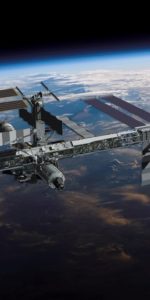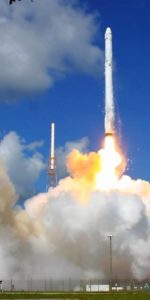
When Commander Mark Polansky docked Space Shuttle Discovery onto the International Space Station (ISS) on 11 December 2006, ten years ago, today, he kicked off an ambitious mission for his STS-116 crew and the incumbent three-man Expedition 14 team. For Polansky and his crewmates—Pilot Bill Oefelein and Mission Specialists Nick Patrick, Bob “Beamer” Curbeam, Joan Higginbotham, and Sweden’s first spacefarer, Christer Fuglesang—would install and activate the P-5 structural “spacer” between the solar arrays of the P-4 and P-6 trusses and deliver a hefty payload of cargo and supplies aboard a single Spacehab module. More significantly, during four sessions of Extravehicular Activity (EVA), the STS-116 astronauts would extensively re-wire the station, bringing its electrical power architecture to “Assembly Complete” and readying it for the arrival of new solar arrays and a trio of pressurized modules from the United States, Europe, and Japan.
As outlined in yesterday’s AmericaSpace history article, the first task of the docked mission was to robotically remove the 4,100-pound (1,860-kg) P-5 truss segment from the shuttle’s payload bay for “hand-off” to the station’s Canadarm2. However, both the shuttle and ISS crews were called to perform an impromptu inspection of the tip of Discovery’s port-side wing using the station’s Canadarm2. The inspection was caused by a minor vibration on a wing sensor in that area, which, in a worst-case scenario, might be indicative of a debris impact. As circumstances transpired, the incident did not require another focused inspection of the left wing area. The inspection, which would have taken place on 13 December, was canceled and Discovery’s heat shield was given a clean bill of health.
The inspection delayed the P-5 unberthing by about an hour. After being handed-off to Canadarm2, the cube-shaped spacer was “hung” overnight over Discovery’s port-side wing, ahead of the first EVA by Curbeam and Fuglesang. The duo spent the previous night in the equipment lock of the station’s Quest airlock, embarking on a relatively new protocol, known as a “Campout Pre-Breathe.” First trialed by Expedition 12/13 crewmen Bill McArthur and Jeff Williams in April 2006 and first used operationally during STS-115 the following September, the protocol saw the airlock’s pressure reduced from its ambient 14.7 psi to 10.2 psi overnight, thereby limiting the amount of time spacewalkers needed to pre-breathe pure oxygen on masks, before they moved to the 4.3 psi pressure of their space suits.
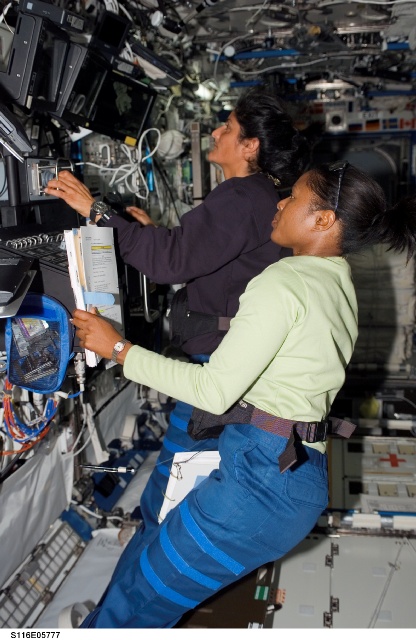
Making her first spaceflight, Joan Higginbotham—the third African-American female astronaut, after Mae Jemison and Stephanie Wilson—was responsible for the robotic operation to maneuver P-5 into place at the furthest-port end of the Integrated Truss Structure (ITS). This required extreme precision on Higginbotham’s part, with clearances as tight as 2.7 inches (6.8 cm) in places. Curbeam and Fuglesang departed the airlock at 3:31 p.m. EST, and the P-5 spacer was officially attached to the station at 5:45 p.m. The entire installation effort was complete by 6:21 p.m.
EVA-1 lasted six hours and 36 minutes and also included the replacement of a failed camera on the starboard side of the ITS, the removal of P-5’s four corner launch locks, the mating of six utility cables, and opening a latch which would allow the P-6 segment to be attached when it was moved from its temporary location atop the Z-1 truss to its permanent location at the outboard end of P-5. Curbeam and Fuglesang returned inside the station at 10:07 p.m. EST. In addition to Fuglesang becoming Sweden’s first man in space and its first spacewalker, Curbeam was already the most EVA-experienced African-American spacefarer and would push his lead still further on STS-116 as the first shuttle astronaut to complete four spacewalks in a single mission.
With EVA-1 behind them, and their primary mission objective complete, the next task was to extensively re-wire the space station. The first port of call was the P-6 truss, which had been installed in a “temporary” location, atop the Z-1 segment of the station, by the STS-97 shuttle crew in December 2000. Its two Solar Array Wings (SAWs) and associated equipment provided early electricity generation and cooling for the infant space station, but was always destined to be relocated to its “permanent” location at the furthest-port end of the ITS. Originally, that relocation should have occurred in 2003, but the loss of Columbia led to an enforced hiatus.
“We’re basically going to unplug space station from that [P-6] truss and plug it into this main truss, which goes span-wise across the station,” Curbeam explained before the flight. “And then, several flights later, they’ll take that [P-6] truss that is sitting on top of the station and put it in its permanent place, outboard of the small [P-5] spacer that we’re going to put in. So that whole port truss will have four Solar Array Wings and all providing power through that main truss to the U.S. lab and the U.S. operating segment and, eventually, through power conversion, to the Russian segment, too.”
In order to fully rotate the already-in-place P-4 arrays, the port-side array of P-6 needed to be retracted, like a giant Venetian blind, into its Solar Array Blanket Box (SABB). If it was left fully deployed, the port-side array would interfere with the rotation of the P-4 arrays. Before launch, it was determined that the port-side array of P-6 needed to be retracted at least 40 percent, in order for the P-4 arrays to have sufficient clearance for movement.
On 13 December 2006, the STS-116 and Expedition 14 crews worked for over six hours issuing dozens of stop-start commands to gradually retract the port-side array. Efforts were complicated by the snagging of guide-wires, which prevented 17 of the 31 “bays” of the 115-foot-long (35-meter) array from retracting properly. As it result, it was only retracted to approximately its halfway mark, leaving about a 16-foot (5-meter) clearance between itself and the P-4 arrays. This proved just about sufficient for the new P-4 arrays to begin rotating and tracking the Sun. Mission controllers then commanded the Solar Alpha Rotary Joint (SARJ) to begin rotating the P-4 arrays at about 8 p.m. EST. Three hours later, valves were opened to allow 300 pounds (136 kg) of ammonia to flow into the P-4 cooling system. Thus began the effort to enable permanent cooling for ISS avionics and electronics.
Curbeam and Fuglesang pressed ahead with their second EVA on 14 December. Venturing outside the Quest airlock at 2:41 p.m. EST, they promptly set to work rewiring half of the space station. The work required Mission Control to power-down about half of all ISS systems, including some lights, communications equipment, ventilation fans, and backup computers, at about 3 p.m. Within two hours, at 4:45 p.m., the Main Bus Switching Units (MBSUs) for Power Channels 2 and 3 had been brought online, one of two external thermal control system loops was operational and the DC-to-DC Converter Units (DDCUs) were successfully regulating power voltages. Having started the EVA around 30 minutes ahead of the timeline, Curbeam and Fuglesang worked briskly and soon made up another half-hour, allowing them to press into a number of get-ahead tasks, including the relocation of two Crew and Equipment Translation Aid (CETA) “carts” on the main truss. By the time they returned to the airlock, EVA-2 had lasted exactly five hours. “There were a lot of cheers on the ground,” remembered Lead STS-116 Spacewalk Officer Tricia Mack. “It just kept clipping along and, the next thing you know, at five hours, they were in.”
Meanwhile, the Mission Management Team (MMT) mulled options for a fourth EVA to fully retract the P-6 array and both Polansky and Lopez-Alegria requested further details before making a decision about whether or not to press ahead with it. One early possibility was that a guide-wire had become snagged in a stainless steel swiveling grommet on one of the array panels and it was repeatedly commanded through a series of “wiggle” tests— effected by moving the Beta Gimbal Assembly (BGA) and vigorous exercise by the Expedition 14 crew—without success. By 15 December, it was decided to effect an inspection task at the end of EVA-3, which would allow for clearer insight before the decision was made to perform a fourth spacewalk.
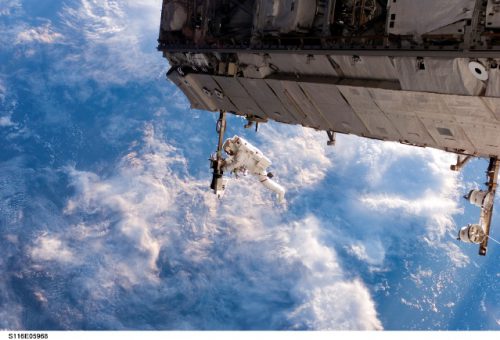
The second half of rewiring the station’s power system, Power Channels 1 and 4, were the task for EVA-3, to be performed by Curbeam and Sunita Williams. Uniquely, this marked only the second occasion that an ISS increment member performed an EVA in direct support of a shuttle assembly mission. Before launch, Polansky rationalized the decision. “Suni’s a first-time flyer,” he told a NASA interviewer. “She’s also going to be doing some spacewalks while she’s on the increment. The best time to get somebody experienced is in a fairly controlled environment. Here you have the chance, with a few changes to our training load, to have Suni train for a spacewalk with the person that she’ll be doing it with up until the time we launch.” Since Williams’ planned EVAs were with Lopez-Alegria, who had launched three months earlier, she had no “recent” training with him. “By the time that she actually does her spacewalk with Mike, they’ll have not trained together in probably six months,” added Polansky. “So the upside here is she can train with Beamer up until the time she launches, like any other shuttle crew would.” As her career progressed, Williams went on to become the world’s most experienced female spacewalker, a title she holds to this day.
Late on the morning of 16 December, Mission Control commanded the other half of ISS systems to power-down and Curbeam and Williams departed the Quest airlock at 2:25 p.m. EST. Working almost exactly to the EVA-2 timeline, they had completed their rewiring task within two hours and by 4:18 p.m. controllers were in the process of restoring power. The spacewalkers installed a new grapple fixture onto Canadarm2 and positioned a trio of bundles of Russian debris shield-panels outside the Zvezda service module, before heading toward the P-6 work site. Using maneuvers which they wryly dubbed the “Beamer Shake” and the “Suni Shake,” they positioned themselves at opposite sides of the array and attacked the stainless steel grommets and guide-wires with a gusto of shaking. Curbeam totaled 19 shakes and Williams 13, whilst their crewmates worked on eight retraction cycles to reel in the array, bay by critical bay.
Their combined efforts succeeded in bringing the array to around 65-percent-retracted, with only 11 bays still to reel in. Midway through the spacewalk, Mission Control announced that STS-116 would be extended by 24 hours, in order to accommodate a fourth EVA to tend to the P-6 array retraction task. In the meantime, Curbeam and Williams returned inside Quest at 9:56 p.m. EST, wrapping up EVA-3 after seven hours and 31 minutes. With all four P-4 channels operational, this positioned the ISS power system in its “Assembly Complete” configuration, ready for the arrival of additional solar arrays and the Harmony, Columbus and Kibo pressurized modules in the fall of 2007 and spring of 2008.
With EVA-4 planned for 18 December, the joint crews spent the previous day preparing for what would earn Curbeam a new record for having performed as many as four spacewalks during a single shuttle flight. Four EVAs had been performed during the final Skylab mission between November 1973 and February 1974 and as many as five discrete “extravehicular” sessions could be recorded for the Apollo 15, 16, and 17 lunar voyages, when one counts a “Stand-Up EVA” and brief periods of cabin depressurization to discard equipment onto the Moon’s surface. However, no previous astronaut had ever performed as many as four spacewalks from the shuttle. Even today, only Scott Parazynski has tied with Curbeam in having completed a quartet of EVAs on a single shuttle flight.
Throughout 17 December, the STS-116 and Expedition 14 crews worked to position Canadarm2 close to the EVA-4 work site and Curbeam and Fuglesang’s space suits were prepared for another excursion and transferred into Quest. With 6.5 hours allocated for the task, the MMT hoped to have the retraction complete within 4.5 hours. Awakened on the morning of the 18th to the sound of the Beach Boys, playing “Good Vibrations,” the spacewalkers exited Quest and were positioned via Canadarm2 close to the P-6 array. The effort required a combined crew efforts, with Williams and Higginbotham at the robotic arm controls and Bill Oefelein choreographing Curbeam and Fuglesang’s every move. Working briskly, they succeeded in guiding the remaining 35 percent of the still-deployed port-side array into its SABB at 6:54 p.m. EST. Finally, the latches along the blanket boxes were locked securely at 7:34 p.m. This left only the starboard-side P-6 array unfurled, with plans for it to be retracted during the STS-117 mission in early 2007, ahead of a relocation of the entire truss segment to its permanent location on the end of the P-5 component during STS-120 in fall 2007.
Returning inside the ISS after six hours and 38 minutes, Fuglesang became—by default—Sweden’s most experienced EVA veteran, whilst Curbeam his existing record as the most spacewalk-seasoned African-American astronaut. Totaling more than 45.5 hours across a seven-EVA career, to this day Curbeam maintains a position within the Top 15 spacewalkers of all time. As for Sunita Williams, her inaugural EVA with Curbeam had marked the start of a glorious spacewalking career. Today she stands as the most EVA-experienced female spacefarer of all time, with more than 50.5 hours spent working in vacuum.
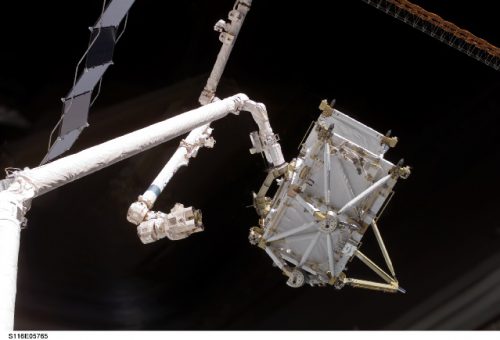
At length, the STS-116 and Expedition 14 crews bade one another farewell and hatches were closed at 2:42 p.m. EST on 19 December. Williams remained aboard the ISS with Lopez-Alegria and Tyurin, whilst Reiter returned to Earth as a crew member aboard Discovery. Separation of the two spacecraft occurred at 5:10 p.m. EST, just two minutes shy of eight full days of joint docked operations.
“From the crew of Discovery, we wish you smooth sailing,” Polansky told Lopez-Alegria, as Discovery reached a distance of about 600 feet (180 meters) from the orbiting outpost. “Thank you for the hard work and we hope you enjoy the new electrical system on the station.” For the flyaround inspection of the ISS, Oefelein assumed manual control and the final separation maneuver was executed at 7:12 p.m. to begin Discovery’s departure from the station’s vicinity, ahead of a return to Earth on 22 December.
For Alaska-born Oefelein—who had earlier become the first person to write a blog during a space mission—the final days in orbit offered him the chance to glimpse his childhood hometown, Anchorage. “It was a night pass, and as we came up the Aleutians, I could start to make out Kodiak, then Homer, Kenai, Soldotna and Seward,” he wrote. “Above them all, from the angle I was looking, was a big bunch of lights that was Anchorage. Just to the north of that, I could even make out Wasilla.” The memory of floating alone on Discovery’s darkened flight deck, looking at seven Alaskan cities, remained with Oefelein long after his return to Earth. “There’s something special about seeing your home from the air,” he closed, “and something I found even better about seeing it from space.”
The final days of the mission were spent executing a final, six-hour checkout of the shuttle’s thermal protection system with the sensor-equipped OBSS boom. Imagery and damage assessment teams at the Johnson Space Center (JSC) in Houston, Texas, immediately set to work analyzing the data and submitted a report to the MMT late on 21 December, giving Discovery’s heat shield a clean bill of health for landing. By that point, Polansky, Oefelein, and Curbeam had also run through a successful day-before-landing checkout of the shuttle’s flight surfaces, including its maneuvering thrusters.
Also during those final days, the STS-116 astronauts deployed a trio of coffee-cup-sized satellites for the Department of Defense’s Space Test Program (STP). First was the Microelectromechanical System-Based PICOSAT Inspector (MEPSI) to evaluate the capabilities of low-power satellites to observe larger spacecraft for damage assessment, followed by the Radar Fence Transponder (RAFT), which housed a range of U.S. Naval Academy student experiments for space surveillance and communications. Finally, Fuglesang and Higginbotham deployed the twin microsatellites of the Atmospheric Neutral Density Experiment (ANDE) to examine the effects of atmospheric drag in low-Earth orbit.
Awakened early on the 22nd to the strains of Perry Como’s “Home for the Holidays,” the crew was notified that three landing sites—at the Kennedy Space Center (KSC) in Florida, at Edwards Air Force Base, Calif., and the rarely-used White Sands Space Harbor, near Alamagordo, N.M.—had been activated to support Discovery’s return home. With a likelihood of rain and low clouds in Florida, and the potential for strong crosswinds in the California desert, the near-perfect outlook in New Mexico made it an ideal third option. The opening landing opportunity for the day was at 3:56 p.m. EST at the Cape, with an Edwards attempt also possible at 5:27 p.m. EST (2:27 p.m. PST) and White Sands available at 5:27 p.m. EST (3:27 p.m. MST). A further seven opportunities, spread across the three landing sites, were available to Discovery on 23 December.
As events unfolded, weather conditions proved poor for the first KSC attempt on the 22nd, with a band of storm-bearing showers threatening to remove Florida from the equation for STS-116. Gusty conditions at Edwards also caused the first California attempt to be called off. However, weather at the Cape improved during the afternoon and Polansky and Oefelein guided Discovery to a smooth touchdown on Runway 15 at 5:32 p.m. EST, concluding a mission which had spent just shy of 13 days in space.
This is part of a series of history articles, which will appear each weekend, barring any major news stories. Next week’s article will focus on the 50th anniversary of the announcement of the Apollo 2 and 3 crews, whose unrealized flights in 1967 might have drawn humanity closer to bootprints on the surface of the Moon.
Be sure to “Like” AmericaSpace on Facebook and follow us on Twitter: @AmericaSpace




